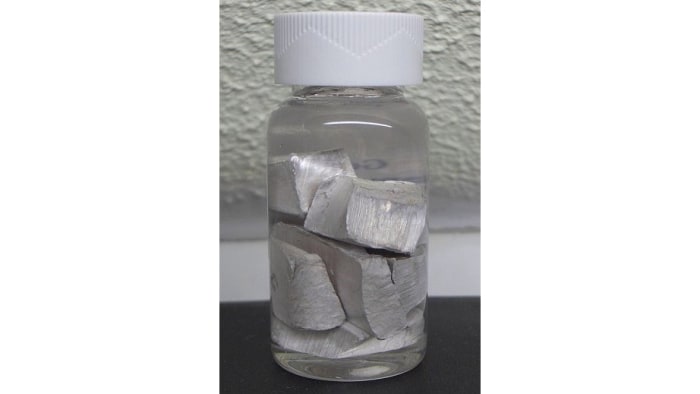Interaction of sodium with various substances
Chemical properties of sodium

Sodium is an alkaline metal in the first group and third period. In pure form it has a silvery color with a metallic shine, is not hard (can be cut with a knife), melts at a temperature of 97.8°С, and has a density of around 0.97 g/cm³.

General characteristics of sodium
Sodium has a high activity and the ability to enter into a reaction violently and quickly with many substances.
Sodium is one of the element that makes up animal and plant cells. The element is found in high concentration in sea water. Sodium is present in several minerals, for example sylvinite (NaCl·KCl). Sylvinite has a heterogenous structure with parts of different colors, including pink, orange, red and blue. Sylvinite is fully soluble in water.

How to work with sodium in the laboratory
In the air, sodium swiftly oxidizes, and becomes covered with a gray film, so the metal is stored in sealed jars under a layer of oil or waterless kerosene. A piece of sodium of required size is cut with a scalpel or knife, without taking the metal out of the kerosene. Sodium is taken out of the jar with tweezers. All tools must be dry — this is a compulsory condition. The metal must not be picked up with bare hands. The container sodium is kept in must not be washed with water – this may cause an explosion. The remains of sodium are removed by adding alcohol to them, and then water can be used to wash the container. You must wear protective glasses when working with sodium.
Here you’ll find safe experiments with sodium compounds.
Reaction of sodium with various substances
Sodium enters into a reaction with all halogens — iodine, fluorine, bromine and chlorine, forming sodium iodide, fluoride, bromide and chloride respectively.

Sodium can also react with phosphorus, sulfur and carbon. Chemical interactions of this kind mainly take place at high temperature.
Sodium enters into a reaction with acids. When sodium reacts with diluted hydrochloric acid, sodium chloride and hydrogen form. The equation of the reaction:
Na + HCl = NaCl + Н₂
When sodium and water interact, sodium hydroxide (caustic soda) forms. Sodium floats to the surface, as it is lighter than water. The active reaction of sodium with water takes place, with the release of hydrogen. From the heat of the reaction, the metal melts and turns into a silvery drop, which darts across the surface of the water and makes a hissing sound. Sometimes the hydrogen released burns with a yellow flame. The equation of the reaction:
2Na + 2H₂O = 2NaOH + H₂